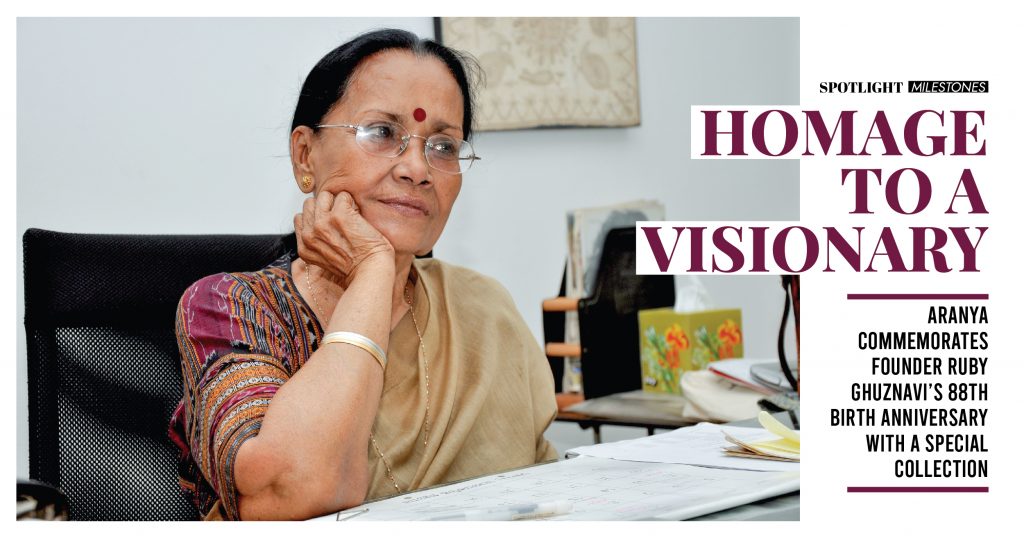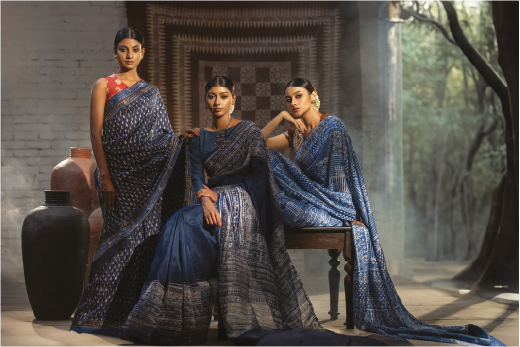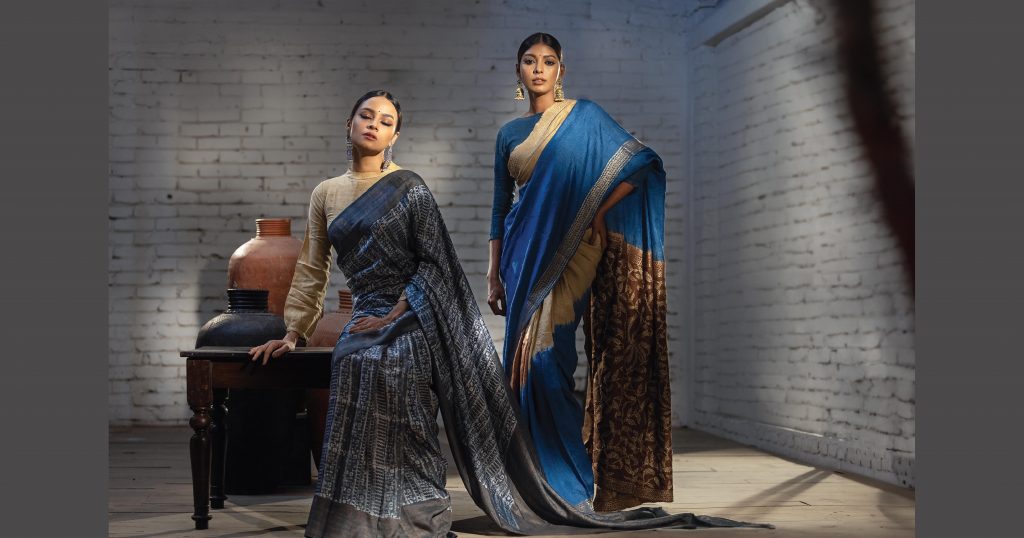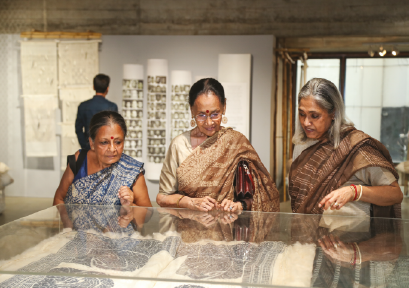
A trailblazer of sustainable practices and artisanal crafts, Ruby Ghuznavi left an indelible mark on the landscape of Bangladesh and beyond. Her journey began in the 1970s when she found herself troubled by the environmental repercussions of river pollution caused by toxic synthetic dyes. This deeply motivated her to explore alternatives, leading her on a transformative path that would redefine Bangladesh’s approach to handicrafts and sustainability.
How It All Began
Driven by a desire to protect Bangladesh’s heritage and environment, Ruby embarked on a three-year government project to revive natural dyes from locally available plant-based materials. To combat the harmful nature of synthetic dyes, she sought not only eco-friendly alternatives, but also the revival of fading crafts and traditional knowledge.
Successfully reviving 6 dyes, later expanding to an impressive 35, Ruby approached the Forestry Department of Bangladesh with a proposal. This collaboration resulted in the department planting more dye-producing plants and trees as part of their afforestation initiatives, marking the start of Ruby’s remarkable journey.
Beyond the Laboratory
In the 1980s, Ruby assumed the role of Project Director for the government-led Vegetable Dye Project. This project propelled her to the forefront of sustainable practices, where her extraction and purification methods became instrumental in large scale high-quality natural dyes production. It also marked a paradigm shift in the industry, as natural dyes transitioned from being a niche interest to a commercially viable alternative to synthetic counterparts.
Besides laboratory work, Ruby played an active role in establishing the National Crafts Council for Bangladesh (Bangladesh Jatiya Karushilpa Parishad). From 2002 to 2005, she led the council as its President, directing efforts towards preserving and promoting the country’s rich and diverse crafts.
Her leadership culminated in the successful hosting of the World Crafts Council – Asia Pacific Regional Assembly in 2003, establishing her further as a global expert in the field.
UNDER RUBY’S STEWARDSHIP AS MANAGING DIRECTOR UNTIL 2011, ARANYA BECAME ONE OF THE FIRST MEMBERS OF THE WORLD FAIR-TRADE ORGANIZATION, SOLIDIFYING ITS POSITION AS A TORCHBEARER OF SUSTAINABLE PRACTICES.
The Birth of Aranya
Ruby looked up to inspirational people like Kamla Devi Chattopadhyay and artist Zainul Abedin for her forays into the world of natural colours and art. After an immensely successful crafts exhibition, Ruby realised the marketability of her artisanal wares to the public. Thus, in 1990 Aranya Crafts was formed, a social business with a steadfast commitment to natural and sustainable production processes. Aranya not only became a symbol of ethical craftsmanship but also gained global recognition for its pioneering approach. Under Ruby’s stewardship as Managing Director until 2011, Aranya became one of the first members of the World Fair-Trade Organization, solidifying its position as a torchbearer of sustainable practices.
Through the commercialisation of dying arts such as the nakshi kantha and jamdani weaving, Ruby enriched the lives of rural artisanal women, especially those affected adversely by the Liberation War. Stuck in a cycle of poverty, these women had to be coaxed and cajoled into producing items for commercial production. They did not believe that people would be interested in purchasing their art. Nevertheless, Ruby persisted in her efforts and gradually, the artisans agreed to take the leap of faith.
“It was very difficult for me to work with four little children to take care of alone. I could not leave them at home by themselves, so at the time, it was very helpful for me to get orders through Aranya and work on them from home,” shared Latifa Begum, a master craftswoman who worked closely with Ruby. “Nowadays, it is difficult to get the true monetary value for all the hard work we put into our products, but Ruby Apa ensured I got the best possible price for them.” Latifa used the money she got for her with household expenses as well as her daughters’ education. “They are all college graduates now and two of them have even completed their masters,” she said. “They all work as teachers in high schools. I managed their wedding expenses with this income as well.”
Weavers initially preferred faster, readily available chemical dyes, bypassing natural dyes as outdated. However, Ruby convinced them of the benefits of Aranya’s collaborative model, where artisans worked together, increasing output and profitability.
Ruby’s creativity, including incorporating nakshi kantha stitches into sarees, boosted Aranya’s popularity. In the 1990s, she trained and empowered 300 Jessore women in the art and prepared female entrepreneurs to manage them. Today, few of these entrepreneurs still manage Aranya’s hundreds of female artisans, who continue to pass down their skills, patiently weaving rural life stories onto naturally dyed cloth.
Ruby’s impact transcended borders, making her a global champion in responsible fashion. She was recognised with various accolades, including the Seal of Excellence for Handicrafts in different categories. Eager to share her knowledge and promote sustainable practices, Ruby organised workshops and seminars, collaborated with textile manufacturers, and advocated for the feasibility of using natural dyes on a commercial scale.
RUBY’S CREATIVITY, INCLUDING INCORPORATING NAKSHI KANTHA STITCHES INTO SAREES, BOOSTED ARANYA’S POPULARITY.
A Unique Colour Palette

Ruby’s expanded colour palette, boasting 35 deep and subdued hues, was met with widespread acclaim. This wasn’t just a feat for Bangladesh; it was a revolution in fashion and sustainability. Known as the ‘Indigo Lady,’ she understood her customers. She trusted them to appreciate the artistry of natural dyes, knowing that each product would be unique. She taught retailers to believe in the value of differentiation, and customers responded, willing to pay more for handcrafted quality.
Ruby’s commitment to quality meant low production, catering to niche markets and ensuring fair wages for her artisans. In a land of vibrant colours, her muted palette of olives, browns, and greys was a breath of fresh air. This introduction to sophisticated fashion was Ruby’s gift to Bangladesh, a legacy still cemented in Aranya’s unique style.
The Rejuvenation of Lost and Dying Arts
Her influence went beyond Bangladesh through roles such as founder member of KARIKA, the Bangladesh Handicrafts Co-operative Federation, an honorary member of the World Crafts Council, and a member of the Jury of UNESCO’s Seal of Excellence, WCC Craft.
Ruby’s mentorship became a cornerstone of her legacy. She inspired young researchers in the field of natural dyes through her dedication, leading to innovative techniques and sustainable business practices. Her invaluable insights were featured in national and international publications, establishing her as a thought leader in sustainable practices.
In 2019, Aranya Crafts, along with three other social businesses dedicated to crafts in Bangladesh, participated in the Jamdani Festival spearheaded by the Bengal Foundation and the World Crafts Council. The project aimed to restore the nearly extinct 200 to 300 count jamdani, a material that held historical significance since the Mughal era. The weaving process was held in Sonargaon, an ecologically and geographically suitable location for producing fine cotton, sustaining jamdani communities for centuries. The site was awarded the status of ‘World Crafts City’ by the World Crafts Council at the Jamdani Festival, marking it as one of the most notable achievements of Ruby’s life.
Life as a Humanitarian
Ruby’s work went beyond crafts, as she advocated for women’s rights, and was a relentless champion for the betterment of society. She served as the Country Delegate for Terres Des Hommes and was long-time member of Naripokkho, as well as a trustee of Transparency International Bangladesh.
The Ruby Collection

Marking their founder’s 88th birth anniversary on 10 December 2023, Aranya decided to honour her by introducing a special collection in her name. Named ‘The Ruby Collection’, the pieces sought to replicate Ruby’s oldest, most original creations. Pictures and samples have been dedicatedly collected by the brand, through word of mouth as well as by flipping the yellowed pages of archived magazines. The primary colours used in this painstakingly replicated vintage collection are natural indigo, browns, and greys. Traditional motifs on natural, handwoven silk and half silk tell a tale of bygone years and the everlasting legacy of Ruby Ghuznavi.

Nawshin Khair, her most diligent apprentice and the Creative Director of Aranya shared, “For over a decade, I shared an office room with Ruby Chachi, observing and absorbing the knowledge of the intricate art of natural dyes and handloom textiles. Through this shared experience, I acquired the skills to mimic her unique colour palette. However, I’ve also cultivated my distinctive styles and palette over time. In Ruby Chachi’s absence, I find myself hesitant to attribute my designs to her legacy. Having dedicated 30 years to design, her collection boasts numerous exquisite pieces. In an effort to honour her memory and preserve her artistic contribution, we aimed to faithfully reproduce Ruby Chachi’s original creations, ensuring her remarkable work continues to thrive.”
Ruby Ghuznavi, with her vision, nerves of steel and sheer determination to uplift the artisans of Bangladesh, is an inspiration for all those who succeed her. The world of crafts misses her immensely, but finds solace in the fact that she left behind a powerful legacy for the future generations to idolise and get inspired by.
If you have a vintage Ruby Ghuznavi piece that deserves to be a part of this prestigious collection, please send a photo to info@aranya.com.bd.
Photographs: Courtesy of Aranya

